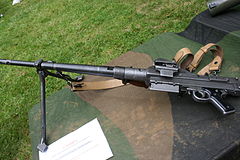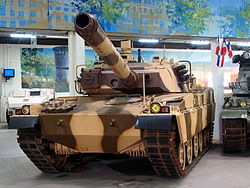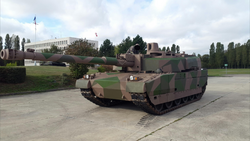Talaharan Army Corps: Difference between revisions
mNo edit summary |
mNo edit summary |
||
| Line 29: | Line 29: | ||
| equipment_label = | | equipment_label = | ||
| battles = {{Collapsible list | | battles = {{Collapsible list | ||
| Tyreseian Civil War | |||
| {{nowrap|Annexation of Amara}} | | {{nowrap|Annexation of Amara}} | ||
| Liberation of Kirthan}} | | Liberation of Kirthan}} | ||
| Line 63: | Line 64: | ||
==History== | ==History== | ||
After the [[Talaharan Revolution]] concluded in 1838, the Central Commune Army was disbanded to prevent a single armed and organized group from exerting undue influence on the new government. The Central Army was composed primarily of defectors from the monarchist cause during the war who had served professionally in the Royal Talaharan Army. The subject of national defense was thus left entirely to the [[Talaharan Black Guard Corps|Black Guards]]. While the [[Talaharan Navy Corps]] was formed in 1845 to directly address littoral defense, land warfare remained entrusted entirely to local militias, albeit well-trained, battle-hardened, and numerous. | |||
In the years following the revolution, additional security threats were cause for concern for the nascent syndicalist republic, including the threat of monarchist [[Yisrael]] and growing civil unrest in neighbouring [[Tyreseia]]. Furthermore, the Yisraeli foothold in the Protectorate of Tarshish, seized from the Kirthan region during the war, could not be dislodged. In 1854, the [[Supreme Legislative Council (Talahara)|Supreme Legislative Council]] approved the creation of a land-based professional fighting force to supplement the Black Guards. In order to curb the potential influence of a uniquely armed and organized group, the size and operation of the force were placed under the purview of the Supreme Council and the [[Executive Council (Talahara)|Executive Council]]. The Navy Corps was subsequently subjected to the same controls. | |||
The new Talaharan Army Corps was formed initially out of dedicated Black Guard veterans who chose to leave their primary industries for a full-time military career. This deprived the Black Guards of many of their more experienced members and materials but assured an experienced core to lead and train the future army. The initial size was capped at 40,000 members, but only 25,000 to 30,000 members enlisted within the first three years. Despite political pressure and concerns over the continued occupation of the Protectorate of Tarshish, military leaders in the Commune considered a military invasion unfeasible. | |||
In 1879, the Talaharan Army Corps saw its first deployment in support of the Sidduni Coup of the Tyreseian government. Only two regiments took part in the two-year operation, but Talaharan doctrine was refined by live combat experience. In the aftermath of the coup and Azmelqart Sidduni's dissolution of his armies to prevent further coups, the Talaharans assisted in training the [[Tyreseian Workers' Navy|Tyreseian Workers' Naval Infantry Service]] in land warfare. | |||
Forty years later, the next major campaign involving the Talaharan Army Corps took place. In the aftermath of the [[West Scipian Wars#Second West Scipian War (1915-1918)|Second West Scipian War]], which was fought between [[Sydalon]] and [[Yisrael]], the weakened state of the latter presented an opportunity for the Talaharan Commune. While Tarshish remained reinforced, it became the subject of a special intelligence campaign to undermine Yisraeli influence. In 1919, the Talaharan Army Corps issued a surprise declaration of war against the Kingdom of Yisrael and rapidly launched an invasion in the south, seizing control over the Amara region, known as the Timna Strip in Yisrael. The Amara region is an oil-rich region with significant Kel Hadar and Kel Tenere populations. Unable to mount an effective counter to the invaders and with additional Army and Black Guard forces holding a firm line over the rest of the border, Yisrael was forced to concede the region after a short conflict. | |||
The Liberation of Kirthan took place in 1951 in the aftermath of the Third West Scipian War. The invasion, supported by local dissidents and protestors, was the first combined arms operation of the TCDF. Naval landings and aerial support allowed Talaharans soldiers to rapidly advance on major military and government targets. The Protectorate's governors were captured and imprisoned but released to Yisrael in the peace process that soon followed. The Protectorate of Tarshish was formally dissolved before the end of 1951 and the region of Kirthan was restored to its traditional extent. | |||
==Structure and organization== | ==Structure and organization== | ||
| Line 241: | Line 252: | ||
| 597 | | 597 | ||
|- | |- | ||
|{{wp|BMPT Terminator|K83T1 | |{{wp|BMPT Terminator|K83T1 Aɣilas}} | ||
| style="background:white;"|[[File:Army2016-202.jpg|center|250px]] | | style="background:white;"|[[File:Army2016-202.jpg|center|250px]] | ||
|[[File:Rubric Coast Partnership Flag.png|23px]] [[Rubric Coast Consortium|Rubric Coast]] | |[[File:Rubric Coast Partnership Flag.png|23px]] [[Rubric Coast Consortium|Rubric Coast]] | ||
Revision as of 20:03, 28 February 2022
| TCDF Army Corps | |
|---|---|
| ⵛⴰⵛⵀⴰⵜ ⵏ'ⵀⴰⵔⴱⴰⴽⴰⵍ Šašhat N'Harbakal | |
 Roundel of the Talaharan Army Corps | |
| Active | Since 1854 |
| Country | |
| Type | Army |
| Role | Land warfare |
| Size | 100,080 |
| Part of | Talaharan Commune Defense Forces |
| Colours | Black Red Dark sand |
| Engagements | List
|
| Commanders | |
| Commander-in-Chief | Executive Council |
| Executor of Defense | Taos Jebar |
| Defense Committee Senior Representative | General Kahina Hamastan |
| Defense Committee Enlisted Representative | Sergeant Karim Jurgutha |
The Talaharan Army Corps (Takelat: Šašhat N'Harbakal N'Talahara; ⵛⴰⵛⵀⴰⵜ ⵏ'ⵀⴰⵔⴱⴰⴽⴰⵍ ⵏ'ⵜⴰlⴰⵀⴰⵔⴰ), officially the Talaharan Commune Defense Forces Army Corps, is the professional land warfare component of the Talaharan Commune Defense Forces. It is directly subordinated to the Defense Committee, where it is represented by General Kahina Hamastan and Sergeant Karim Jugurtha.
The Army Corps has over 100,000 active service members. There is no reservist force. Talahara does not practice conscription and all members of the Army Corps are professional, full-time soldiers. In addition, administrative staff from the Black Guards and civilian agencies fulfill supplemental work.
In its current incarnation, the Talaharan Army Corps has seen few deployments. In terms of major deployments, however, it has a strong history of success and rapid response. Traditional Talaharan land doctrine calls for large-scale, rapid advances with multiple units operating in tandem to capture open ground quickly, with a second line to move into key target areas once supply lines have been overwhelmed. These tactics have frequently led to victory in the geography of Northern Scipia, and have been developed upon in the decades since Talahara's last major conflict.
History
After the Talaharan Revolution concluded in 1838, the Central Commune Army was disbanded to prevent a single armed and organized group from exerting undue influence on the new government. The Central Army was composed primarily of defectors from the monarchist cause during the war who had served professionally in the Royal Talaharan Army. The subject of national defense was thus left entirely to the Black Guards. While the Talaharan Navy Corps was formed in 1845 to directly address littoral defense, land warfare remained entrusted entirely to local militias, albeit well-trained, battle-hardened, and numerous.
In the years following the revolution, additional security threats were cause for concern for the nascent syndicalist republic, including the threat of monarchist Yisrael and growing civil unrest in neighbouring Tyreseia. Furthermore, the Yisraeli foothold in the Protectorate of Tarshish, seized from the Kirthan region during the war, could not be dislodged. In 1854, the Supreme Legislative Council approved the creation of a land-based professional fighting force to supplement the Black Guards. In order to curb the potential influence of a uniquely armed and organized group, the size and operation of the force were placed under the purview of the Supreme Council and the Executive Council. The Navy Corps was subsequently subjected to the same controls.
The new Talaharan Army Corps was formed initially out of dedicated Black Guard veterans who chose to leave their primary industries for a full-time military career. This deprived the Black Guards of many of their more experienced members and materials but assured an experienced core to lead and train the future army. The initial size was capped at 40,000 members, but only 25,000 to 30,000 members enlisted within the first three years. Despite political pressure and concerns over the continued occupation of the Protectorate of Tarshish, military leaders in the Commune considered a military invasion unfeasible.
In 1879, the Talaharan Army Corps saw its first deployment in support of the Sidduni Coup of the Tyreseian government. Only two regiments took part in the two-year operation, but Talaharan doctrine was refined by live combat experience. In the aftermath of the coup and Azmelqart Sidduni's dissolution of his armies to prevent further coups, the Talaharans assisted in training the Tyreseian Workers' Naval Infantry Service in land warfare.
Forty years later, the next major campaign involving the Talaharan Army Corps took place. In the aftermath of the Second West Scipian War, which was fought between Sydalon and Yisrael, the weakened state of the latter presented an opportunity for the Talaharan Commune. While Tarshish remained reinforced, it became the subject of a special intelligence campaign to undermine Yisraeli influence. In 1919, the Talaharan Army Corps issued a surprise declaration of war against the Kingdom of Yisrael and rapidly launched an invasion in the south, seizing control over the Amara region, known as the Timna Strip in Yisrael. The Amara region is an oil-rich region with significant Kel Hadar and Kel Tenere populations. Unable to mount an effective counter to the invaders and with additional Army and Black Guard forces holding a firm line over the rest of the border, Yisrael was forced to concede the region after a short conflict.
The Liberation of Kirthan took place in 1951 in the aftermath of the Third West Scipian War. The invasion, supported by local dissidents and protestors, was the first combined arms operation of the TCDF. Naval landings and aerial support allowed Talaharans soldiers to rapidly advance on major military and government targets. The Protectorate's governors were captured and imprisoned but released to Yisrael in the peace process that soon followed. The Protectorate of Tarshish was formally dissolved before the end of 1951 and the region of Kirthan was restored to its traditional extent.
Structure and organization
Equipment
Infantry equipment
| Personnel protection | |||||
|---|---|---|---|---|---|
| Model | Image | Origin | Type | Notes | |
| Tryamut 42 | Combat helmet | ||||
| 'Awansunfas 40 | Gas mask | ||||
| Small arms | |||||
| Model | Image | Origin | Type | Calibre | Notes |
| Raza 78T2 | Assault rifle | 7.5×35mm | Standard service rifle | ||
| Baz 5T4 | Battle rifle | 7.5×54mm | Former service rifle, limited conversion to precision rifles, ceremonial use | ||
| Isk 00 | Pistol | 9×25mm 10×25mm |
Standard service pistol | ||
| Nakar 44 | Revolver | 9×25mm 9×33mmR |
Awarded after 10 years of service, limited use by special forces | ||
| Imik 13T2 | Submachine gun | 9×25mm 10×25mm |
Limited use by vehicle crews and special forces | ||
| StKbA 2T3 | Medium machine gun | 7.5×54mm | Section support and vehicle-mounted weapon | ||
| StKbX 79T2 | Heavy machine gun | 13×99mm | Vehicle-mounted weapon | ||
| Qajarsin 92T2 | Sniper rifle | 7.5×54mm | Bolt-action, converted from Qajar 92 service rifles | ||
| Schaɣ 43 | Anti-matériel rifle | 13×99mm | Bolt-action, limited use by special forces | ||
| Personnel ordnance | |||||
| Model | Image | Origin | Type | Notes | |
| Qanbulagar 40 | Infantry mortar | ||||
| OSDM 101 | Grenade | ||||
| OSPF 137 | Rocket-propelled grenade | ||||
| Mintagar 44 | MPATS/MPADS | ||||
Vehicles
| Main battle tanks | |||||
|---|---|---|---|---|---|
| Model | Image | Origin | Type | Armament | Quantity |
| S95T1 Ahera | Gen 3 MBT |
|
318 | ||
| S83T2 Ahera | Gen 2.5 MBT |
|
634 | ||
| S65T3 Ahera | Gen 2 MBT |
|
597 | ||
| K83T1 Aɣilas | Combat support missile tank |
|
156 | ||
| S95T4 Ahera | Gen 4 MBT (Experimental) |
|
6 | ||



















